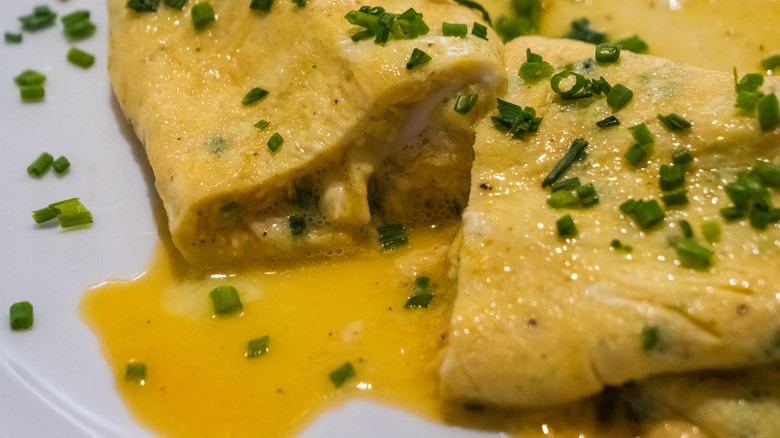Daniel Boulud's Unique Trick For Perfect Omelets - Exclusive
Daniel Boulud is one of the most decorated chefs in history. He's earned James Beard Awards, Michelin stars, and a Lifetime Achievement Award from the World's 50 Best Restaurants. But no matter how many accolades a chef receives and how fancy their restaurants are, one of the best ways to see how well someone can cook is by watching them prepare eggs. Egg cookery is all about using the mastery of technique to transform one of the most basic ingredients into something sublime.
Of course, Daniel Boulud makes immaculate eggs. He cooks omelets using an unusual technique: Instead of just adding the beaten eggs to one pan, he divides them. Half of the eggs get cooked in a skillet to make the exterior of the omelet, and the other half are cooked in a double boiler to create a decadent soft scramble. To assemble these components into an omelet, he wraps the omelet shell around the scrambled eggs.
Tasting Table spoke with Daniel Boulud in an exclusive interview about the 30th anniversary of his restaurant DANIEL. We also took the opportunity to ask him about his special omelet technique. According to the chef, "It's called an omelet fourrée, and 'fourrée' means 'stuffed.'" He told us his reasoning behind the technique and where he learned it.
The omelet fourrée comes from grueling chef competitions
Per Daniel Boulud, the idea for an omelet fourrée comes courtesy of MOF chef competitions. MOF (Meilleur Ouvrier de France) is a title bestowed on the highest-performing French craftspeople in a variety of disciplines. The MOF designation has only been granted to a little over 200 chefs in history, making it one of the most prestigious honors a chef can earn. The title is given to chefs who can pass a rigorous and grueling culinary test. "Everybody has very strict guidelines on how to cook an egg, and they have to do it to perfection. Sometimes chefs use this technique that will combine the basic technique of an omelet and then the basic technique of scrambled eggs and put the two together," Boulud told us.
He said this method is unique to these competitions. "It is not practiced in restaurants or anything like that, and it requires a little bit of a technician to be able to do it right." While this technique may be too fussy for restaurant kitchens, if you're trying to make a French omelet at home, it might help you achieve perfect results. The Platonic ideal of a French omelet is a thin sheet of eggs enrobing perfectly soft-scrambled curds. If you try to do this the conventional way (all at once in the same pan), it can be hard to nail the texture. While it's also challenging to babysit a double boiler of scrambled eggs while cooking an omelet skin at the same time, at least with this method, you can have perfect control over both components of the omelet.
You can dine at DANIEL at its location on 60 E. 65th St. in Manhattan Tuesday-Sunday from 5 p.m. to 10 p.m.

